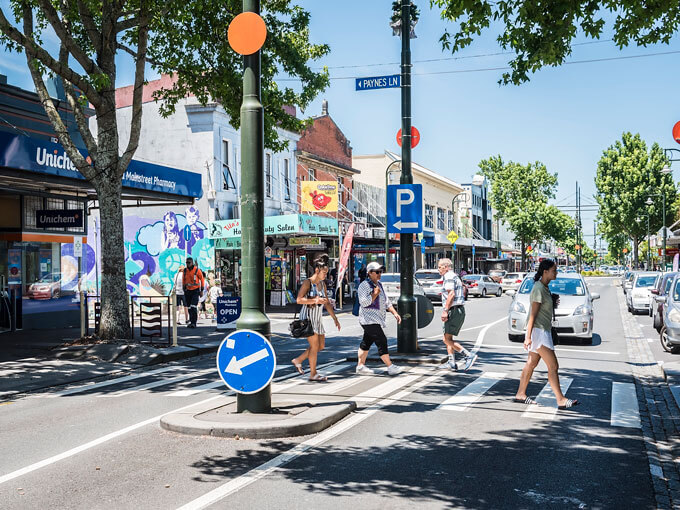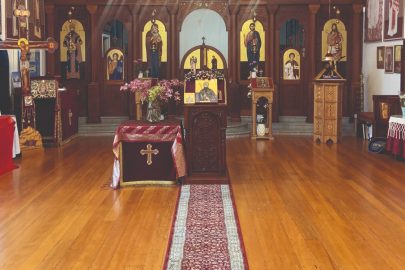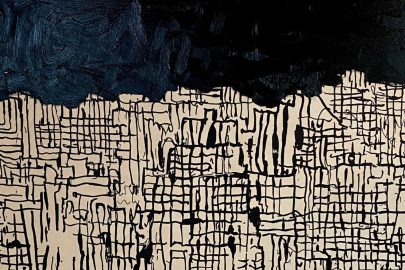Apr 3, 2019 Urban design
Hayden Donnell visited four of Auckland’s regional town centres earmarked for large-scale development to find out what they look like now, what they’ll look like in the future and how that change is going to take place.
This story initially appeared on OurAuckland and is shared with permission.
On Queens Road in Panmure, Deborah Cope is going through her morning routine. She buys a few things from the dairy and sits on the bench outside talking to people she recognises. Cope has been living in Panmure for 30 years and recognises almost everyone. The locals are familiar. But the town centre itself is vastly different from the one she discovered when she first arrived in Auckland. She remembers a bustling shopping hub dotted with brand-name stores, banks, cafes and restaurants. These days, the bigger stores have shifted 3.5km down the road to take up residence at the Sylvia Park shopping centre; others have closed due to the struggle to compete with the giant mall.
What we talk about when we talk about Auckland
When we talk about the future of Auckland, we don’t always think about places like Panmure. We debate waterfront stadiums, or point to the high-rise apartments under construction. Even when it comes to a project with the city-defining scope of the City Rail Link, we usually note first how many more people it will shuttle in and out of the city centre. In many ways that’s justified: not only is it a vital business and transport hub, it’s also the fastest-growing residential area in Auckland.
But it’s only one part of the story. Billions of dollars are being invested into making sure it isn’t an island and that it’s supported by a city-spanning chain of town centres where people can buy affordable homes, make a living, or just enjoy a coffee and some shopping. Thousands of new homes are planned in and around these areas that will help to revitalise them. Whole new business districts that will provide employment opportunities are in the works. It’s a vast undertaking that will shape the city in decades to come. We may zone in on Queen Street in the CBD, but many planners believe it’s what happens to places like Queens Road in Panmure that will truly transform Auckland into an international city.
The largest urban transformation project in NZ
Cope doesn’t know it, but her seat next to the dairy is at the heart of the largest urban transformation project in New Zealand. As the council’s redevelopment arm, Panuku, plans the revitalisation of the Panmure town centre, the Tamaki Regeneration Company is building 7500 homes in the area.
“We know that urban regeneration on the city fringe is an important part of Auckland’s long-term development, alongside greenfield developments slightly further out on the isthmus,” says Shelley Katae, the company’s general manager of strategy and performance. “It’s about accommodating the city’s growth and providing people with options to live and work. As part of this, it is important to maintain a range of places where businesses can locate, innovate, grow and deliver quality jobs in close proximity to the city centre, along with good access to transport and infrastructure.”
When you look at the project’s main areas of focus – social transformation, economic development, placemaking and housing resources – you see how complex and multifaceted regeneration is. It’s not just about physical space. So along with better, healthier housing options, Panuku’s revitalisation of the town centres and the development of Tamaki’s parks and reserves, the company is also establishing a 30-year education strategy with the government and local schools to develop a skilled labour force and working with Auckland Tourism, Events and Economic Development on a Tamaki employment precinct strategy. As part of that, the company launched the Tamaki Jobs & Skills Hub in December 2016 to connect local employers with local job seekers, and more than 400 local people have been placed in employment so far.
Cope is happy to hear about the plans. More people in the area will help inject some life back into it, she says. “We want our Panmure back. We’ve got the bus station right here, the train station right here. So why not have more business right here?”
Encouraging new thinking
Penny Pirrit, Auckland council’s director of urban growth and housing, says part of the challenge in town centres like Panmure is that we have changed the way we shop. “We need to encourage the community, businesses and landowners to think of opportunities other than retail, such as housing, business start-ups and community activities that can bring new life to these town centres. The council can partner with local landowners on new developments but sees it has a key role in showing what can be done by using its own land. This is often enough to spur the private sector into doing changes of its own. Though that may not result in a Panmure town centre that looks exactly like the retail-dominated shopping strip of the past, it will make the area a better meeting place for the community. More people will bring more services. And when new employment and job opportunities are created, that means that sense of community, that sense of place, can keep on happening.”
Ben van Bruggen, urban design strategy manager at the Auckland Design Office, says the economic and social health of a place like Panmure is inextricably linked with the rest of Auckland. The city can’t survive with a strong city centre if its town centres are decaying, he says. “Some may think that a city centre is the icing on the cake, but nobody likes just icing. You’ve got to have the cake as well.”
Back at the dairy, Cope waves at a passing bus driver and shouts, “Thank you, driver”. “I love this place,” she says. “I do everything here. I don’t want to go anywhere else. I like the people. I like the shopkeepers. I believe that everybody round here has got each other’s backs.”
Onehunga on the up
If Panmure is waiting to realise its potential, Onehunga is already flourishing. Its bustling main street looks like a distillation of Auckland – vibrant, multicultural and prosperous. There are second-hand stores and flash cafes. Jewellers and Chinese takeaways. It’s evidence of what can happen when private investment is paired with public infrastructure. The centre is making heavy use of two big advantages: a train station that puts it within 25 minutes of the city, and the Dressmart retail mall.
Tongi Turua is in town to have sushi with her mum, Sandra Turua, on the main street, Onehunga Mall. She says the area used to feel unsafe at times, but that’s changed in recent years. “I think the good thing about it is there’s so many different shops now. It pretty much has everything here. It’s got everything and it’s close to everything.”
Panuku has plans to build on Onehunga’s success. It owns 3.8ha in the town’s lengthy 10-block centre and is looking to establish about 720 new apartments and residential units, including 240 in the next three years, along with 13,600sq m of commercial space. Its acting head of design, Deborah Lee Sang, says places like Onehunga are vital as both secondary economic hubs and showcases for Auckland’s culture. She points to places like Sydney, where the central business district is supplemented by outer centres and villages that give a truer sense of the city’s identity.
“One of the great things about Onehunga is its diversity. If you walk down Onehunga main street, that’s what Auckland looks like. So that’s a real defining quality of Onehunga that would be sad to lose. We have to find a way of maintaining that.”
Mixed reaction to Takapuna developments
At 10.30 on a Tuesday morning, Takapuna beach is already buzzing. Children are climbing through the town centre’s new $1 million playground. People are sunbathing and swimming. The beachside cafes are filling up. By comparison, the town’s main street, Hurstmere Road, is a bit lifeless. A few people are lining up at the cafes, but most of the stores are still empty.
Carrie-Ann Webb and Dean Henderson are having a coffee about halfway down the road, just metres from the Anzac Street car park. The centrally located lot is at the heart of a heated debate over the future shape of the area. Panuku plans to develop part of it into a town square, while working with the private market to create shops, offices and apartments.
Henderson, who works in construction, is in favour of the move. “Development’s a good thing. It’ll bring in more people from the city to the Shore. It’s good for the economy. I know a lot of shops are worried about it but I think it’s a good thing because there’ll be more foot traffic.” Webb isn’t so sure. She worries about being able to park near the beach. “I have kids and they’re all little,” she says. “Being able to park easily with them is my main thing.”
Lee Sang says developing the Anzac Street lot is not an effort to cut down on parking, but to make it less of a main feature of our town centres. By bringing more people and shops into the town centre, Panuku is trying to create a community where locals can work, shop and socialise in one place. “Think about the cities where you go on holiday and they have services right on their doorstep. Those are the things that Auckland hasn’t been doing well. We’re used to a sort of monocentric way of thinking, where we focus on the city centre as the place we all commute to. That creates problems. There’s so much more to Auckland. Spreading business round does make sense and when people can see opportunity in their own area, that’s got to be better. Better and more time-efficient for people and better for the environment.”
Opportunities abound in Henderson
Of all the four centres, Henderson may have the most opportunity. The western suburb is in a prime location for redevelopment. Being on a major rail line will put it within 46 minutes of Aotea Square once the City Rail Link is built, cutting the time it takes to get there by 16 minutes. The council has designated it as one of 10 major regional hubs and earmarked it for 3000 extra homes in the next decade. But few people there seem keen to talk about the economic opportunities awaiting the town.
Peggy Cheung says she would love to see more parks where she can go on walks with her grandson. Bipasha Chowdhury says she’d like more public spaces where she can meet up with friends. “We need more places to hang out. There’s not too many options if you want to just hang around,” she says. David Poulson would like more of the shared spaces that are being successfully developed in the city centre. “I’ve been here nine years. I just like the people. They’re friendly. Everybody gets on. Everybody looks out for each other.”
When you look at the council’s plans, you get a sense of the structural changes it wants to achieve in town centres like Henderson. It wants to transform the city into a chain of humming economies, linked by an upgraded train network, cycleways and better bus services. That overarching strategy can seem impersonal, a little removed from what people like Poulson, Chowdhury or Cheung are saying they want: more community. But when it comes down to it, that’s what’s behind every seemingly dry planning document.
It’s all about interaction
Every new busway, or business, or community centre is fundamentally about human interaction, whether it’s allowing people to buy jeans, creating jobs that are closer to where they live or giving them an opportunity to have lunch at a nice cafe with their mum. All these billions of dollars, all these strategies, are really aimed at achieving one thing: a bit more connection.
That’s important, not just for our town centres, but for the future of Auckland. The only other option is for the city to sprawl outwards and become increasingly dislocated. Instead, the council is trying to bring more businesses, homes and services into centres, in the hope it will make Auckland a better place for people.
Councillor Chris Darby, chairman of the planning committee, says town centres are truly renewed when people feel like they can shape them in some way. “We’re human beings. We’re herd animals. And we like to socialise. And I believe there’s an increasing love affair with things local. With local centres. When you get a sense of belonging, a sense of ownership in a place, you get a whole renewed strength in that place.”
His words bring to mind what Cope said in Panmure about people in her town always having each other’s backs. It can’t be measured on a spreadsheet as well as economic growth or transport outcomes, but the main thing people want out of their town centre – whether it’s Panmure, Onehunga, Takapuna or Henderson – is to connect with other people, to feel part of a community.
This story was first published on Our Auckland









